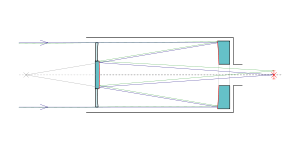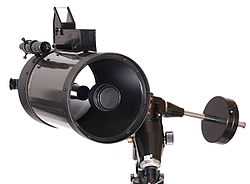Schmidt–Cassegrain telescope

The Schmidt–Cassegrain is a catadioptric telescope that combines a cassegrain reflector's optical path with a Schmidt corrector plate to make a compact astronomical instrument that uses simple spherical surfaces.
Invention and design

The Schmidt-Cassegrain was invented in 1940 by James Gilbert Baker as a modification of Bernhard Schmidt's 1931 Schmidt camera.[1] As in the Schmidt camera this design uses a spherical primary mirror and a Schmidt corrector plate to correct for spherical aberration. In this Cassegrain configuration the convex secondary mirror acts as a field flattener and relays the image through the perforated primary mirror to a final focal plane located behind the primary. Some designs include additional optical elements (such as field flatteners) near the focal plane.
The first large telescope to use the design was the James Gregory Telescope at the University of St Andrews.
Applications
The Schmidt–Cassegrain design is very popular with consumer telescope manufacturers because it combines easy to manufacture spherical optical surfaces to create an instrument with the long focal length of a refracting telescope with the lower cost per aperture of a reflecting telescope. The compact design makes it very portable for its given aperture, which adds to its marketability. Their high f-ratio means they are not a wide field telescope like their Schmidt camera predecessor but they are good for more narrow field deep sky and planetary viewing.
Derivative designs

While there are many variations, (both mirrors spherical, both mirrors aspherical, or one of each) they can be divided into two principal design forms: compact and non-compact. In the compact form, the corrector plate is located at or near the focus of the primary mirror. In the non-compact, the corrector plate remains at or near the center of curvature (twice the focal length) of the primary mirror. Typical examples of the compact design are Celestron and Meade Instruments commercial instruments, combining a fast primary mirror and a small, strongly curved secondary. This yields a very short tube length, at the expense of field curvature. Most compact designs from Meade and Celestron have a primary mirror with a focal ratio of f/2 and a secondary with a focal ratio of f/20 yielding a system focal ratio of f/10. One notable exception is the Celestron C-9.25, which has a primary focal ratio of f/2.3 and a secondary focal ratio of f/23, the result being a slightly flatter field and a slightly longer tube aspect ratio than most other compact designs.
Non-compact designs keep the corrector at the center of curvature of the primary mirror. One very well-corrected design example would be the concentric (or monocentric) Schmidt–Cassegrain, where all the mirror surfaces and the focal surface are concentric to a single point: the center of curvature of the primary. Optically, non-compact designs often yield better aberration correction and a flatter field than a compact design, but at the expense of longer tube length.
See also
- List of telescope types
- Maksutov telescope
- Ritchey–Chrétien telescope
- Schmidt camera
- Schmidt–Newton telescope
References
- ↑ Linfoot, E.H. (1956). "Colloquium on Schmidt optics". The Observatory 76: 170–177. Bibcode:[http://adsabs.harvard.edu/abs/1956Obs....76..170. 1956Obs....76..170.]
External links
![]() Media related to Schmidt-Cassegrain telescopes at Wikimedia Commons
Media related to Schmidt-Cassegrain telescopes at Wikimedia Commons